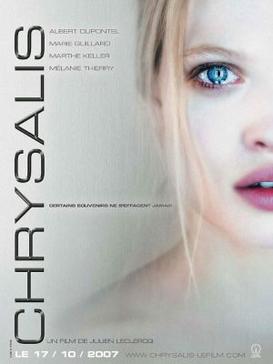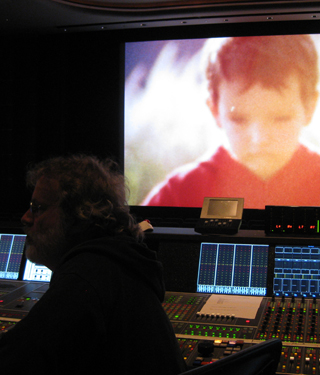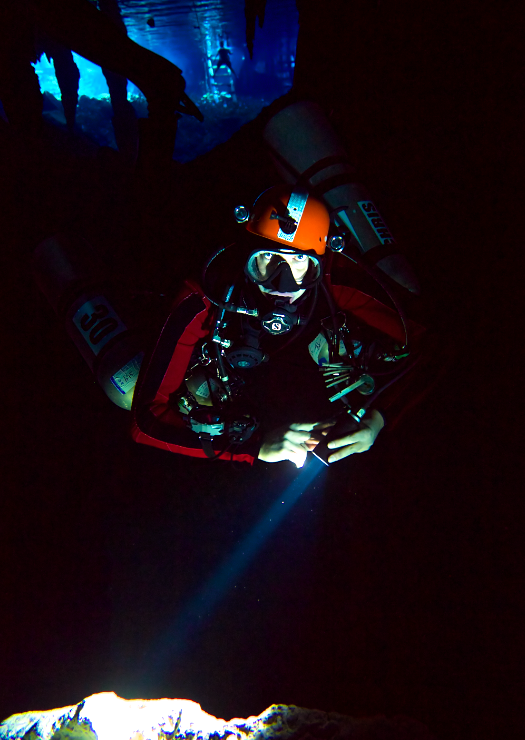 Sound designer Sylvain Lasseur is not just bi-coastal; he’s bi-contintental, working part time in Paris and part time in Los Angeles!  We recently had a chance to ask him a few questions about how he uses Kyma for 5.1 sound design and to explore some of the differences between post production work in Paris and Los Angeles.  By the end of the interview, the discussion turns to food, wine, and the Marx Brothers.  Read on!
Sound designer Sylvain Lasseur is not just bi-coastal; he’s bi-contintental, working part time in Paris and part time in Los Angeles!  We recently had a chance to ask him a few questions about how he uses Kyma for 5.1 sound design and to explore some of the differences between post production work in Paris and Los Angeles.  By the end of the interview, the discussion turns to food, wine, and the Marx Brothers.  Read on!
SSC: Sylvain, you’re currently based both in Los Angeles and Paris. How do you split your time between the two? (e.g. is it summers in LA and winters in Paris? Or does it depend on which project you’re working on?)
SL: In fact, it depends on the projects. The ideal thing would be to spend winters in LA and summers in Paris, but that’s just a question of weather and has nothing to do with sound!
 SSC: You graduated from the Louis Lumiére Cinema School in France. How did  you decide to attend that school? Have you been interested in cinema since you were a child? Were you always interested in sound design?
SL: I’ve been interested in sound since the age of about twelve years old. I learned to play the piano and I had a Uher portable tape recorder to record sound for slideshows, to record music, etc…  The next natural step was to study at a school where I could learn about sound. During my studies, my interest in cinema began to grow and it finally took over.
SSC: What are some of the movies that most inspired you to pursue your profession?
 SL: The first three Star Wars and The Right Stuff convinced me to embrace the profession of Sound Editor and Sound Designer even though, in France, at that time, “Sound Design” was a very hazy notion. More recently, The Curious Case of Benjamin Button and No Country for Old Men inspired me to continue to progress in my profession.
 SSC: You’ve made a specialty of designing sounds for 5.1 surround. Do you conceive of the sounds with surround in mind from the outset?
SL: In fact, I begin each movie by asking myself, “What sounds would serve the movie and enhance the story being told?” –this before even considering the use of surround.
Some movies need a lot of surround and others just a little bit. For that reason my  Kyma modules are ready for 5.1, giving me the tools to do as much or as little as is needed. But if there is a recurrent sound in the movie, I often design the sound first and then I apply a process to put it into surround on each recurrence, as necessary.
SSC:Â Do you place independent material in the surrounds? Â Or processed versions of the other channels?
SL: I have no specific recipe for that either. With ambience or atmosphere, it can be interesting to place independent material in the surround. Â It’s also very interesting to use a processed version of the stereo channels (granulated, pitched, delayed….) in the surround. Here again, it depends on the movie. The director and the story guide you.
SSC: In your opinion, what is the most powerful use for surround sound?Â
SL: Surround sound creates and defines the visual space in a film, creating a third dimension. It gives you the opportunity to shrink or enlarge the visual space through audio. It’s also very powerful for sound fx such as spaceships passing by…
SSC: Is there such a thing as “the Hollywood sound”? Similarly, do French films have a particular “sound”? If your eyes are closed, can you sometimes tell where a film was made just by the sound, even before the first word of dialog is heard?
SL: In general, French movies are more intimate and American movies are more spectacular (even with your eyes closed)!  The “music” of the French language, (pronunciation, tone, tonic syllable emphasis), and the English language are very different. It seems to me that there is more flexibility when mixing English dialogue than French dialogue.  The dynamic, the spectrum, the use of the bass and the use of the surround are different from language to language. I’ve never tried, but if I closed my eyes I would probably be able to hear the difference between a French or an American sound track.
 SSC: Is there a difference in the way post production is done in US films and French films Or does this vary more from film to film than it does from country to country?
 SL: I would say that the big difference is the budget. You just have to compare the sound crew of a French movie and an American movie to see the difference. In France, most of the time I am alone or with an assistant to edit and design the sound for a feature film, usually with less time than for an American film.
In America, a sound crew is composed of a Sound Supervisor, a Sound Designer and multiple Sound Editors. That makes a huge difference! In America, each person’s work is more specialized, the time is longer and the budgets are bigger… which changes everything about the way the work is done.
Of course, this process varies from film to film depending on the film and the budget. That said, most of the time, the needs of a French movie are not the same as an American movie.
SSC: Can you describe your working process with director Catherine Breillat?
 SL: I have done five movies with Catherine Breillat, so we have built up a very confident relationship. She begins by explaining to me what her movie needs, then I work on it for a while. Periodically she comes to my studio to listen to my “work in progress”. She tells me what she likes and doesn’t like, I make the appropriate adjustments, and so forth. Before the mix, she has heard and approved all the sound editing and the sound design. She is very specific about what she wants.
 Â SSC:Â Were you able to utilize Kyma on The Last Mistress?
 SSC: Were you able to utilize Kyma on The Last Mistress?
SL: Yes, I used Kyma for atmosphere, wind and sound effects.
SSC: You sometimes control your Kyma sounds with the pitch and level of your voice. Can you compare this to using a  fader or other controller?
 SL: I have to say that I was a singer in a band for a while. I feel comfortable using my voice and find it more intuitive and immediate that way. I also find that it’s more alive and organic, especially when I manipulate animal sounds. When I do this, sync to picture, I find good intonations and accents more quickly than with a fader or other controller.

SSC:Â Can you point us to a particular scene in one of your films where we can listen for Kyma?
SL:Â Â I can think of a couple of examples where I used two really different approaches:
Chrysalis for the sound fx, especially at the beginning of the movie and
The Trail (La Piste) for the wind in the desert, especially at the end of the movie when there is a wind storm.

SSC: What advice would you give to a sound designer who is just starting to learn Kyma?
SL: Kyma is like a language. You have to learn the vocabulary and the grammar before you can express yourself and become fluent. So, read the manuals (a few times), be patient, persevere and don’t forget to break the rules…
Kyma is so modular and flexible, it’s like an open invitation to create. The possibilities are endless…Â It’s just a question of language!
SSC: Do you have a set of “tools” that you’ve created for yourself in Kyma that you come back to whenever you are working on a film?
SL: Yes, I have a set of tools that I’ve created for myself, all oriented 5.1. Most of the time, I come back to this set of tools, but I continue to create new “sentences” all the time, when I have an idea (and time to do it).
SSC: Can you reflect on your “process” for creating new effects in Kyma? Do you start with your favorite Sounds and modify them? Do you look through the Sound Library? Or is it different every time?
 SL: In fact, it’s different every time. I can start with a sound, modify it, or take just a part of the sound to add it to an another sound or part of an another sound. Sometimes, I start with nothing and I build the “sentence” I want. Sometimes, I look through the Sound Library, which is a gold mine of inspiration.
(NB., You can hear more of Sylvain’s Kyma sound design work on his web site.)
SSC:Â Have you ever intentionally left a scene completely silent?
SL: I have no recollection of having left a scene completely silent, but almost silent, yes! Silence and nuances contribute to the dynamic. I can’t imagine listening to a philharmonic orchestra playing a symphony forte, with no silence, for an hour and a half. It would be unbearable!  For me, two perfect examples of the judicious use of silence, juxtaposed with “interesting” sound are: No Country For Old Men and Mulholland Drive. Very inspiring.
SSC:Â Describe your ideal meal ((who would be there, what is on the menu, where is it, what does the table look like, etc)
 SL:
FADE IN: Ext.:Â North rim of the Grand Canyon on a beautiful summer day, before sunset….
A table is dressed on two interlaced grand Steinway pianos on the edge of the North rim. Wolfgang Amadeus Mozart and Herbie Hancock are playing a free adaptation of the “Sound of Silence”.
Superimposed, scroll the credits in alphabetical order:
Ethan and Joel Coen…… The Directors
Albert Einstein…. Relatively as Himself
Herbie Hancock…. As Himself
Nelson Mandela…. As Himself
Wolfgang Amadeus Mozart… As Himself
My Wife… As My Wife
Me… Â Â As Her Husband
And:
The Marx Bros… As The Waiters
CLOSE UP: On the Menu
Appetizer:Â French Oysters served on the half shell
accompanied by grilled lobster tails
Wine: 1959 White Mersault, Premier Cru
Main Course:Â Roast Venison, sauce Grand Veneur
accompanied by a fricassé of wild  French mushrooms
Wine: 1961 Chateau Margaux
Followed by:  Arugula & Warm Chèvre
As you may have noticed, women are woefully lacking at this meal, so I decided to include them for dessert!
Invited are:
Lucille Ball….. As Lucy Ricardo
Coco Chanel…. As Herself
Rita Hayworth… As The Beautiful Woman
George Sand…. As Herself
Meryl Streep….. As Julia Child
Dessert:   The most fabulous chocolate cake in  the world (or any dessert, as long as it’s  chocolate!)
Digestifs: Â Aged Amber Rum, Poire Williams, Â Mirabelle….
(and cigars for the Marx Bros.)
And may the party continue until dawn….
….. or we could just order in pizza!
SSC: Thank you, Sylvain! Â I think it’s time for all of us to order out for pizza and watch your show reel on line!
 “Working from a script shaped more by sound than words, insight comes at us in primal waves. The heart-wrenching sobs, the gut-churning nausea, the keening and, perhaps most profound of all, the silence. It all carries specific meaning.”
“Working from a script shaped more by sound than words, insight comes at us in primal waves. The heart-wrenching sobs, the gut-churning nausea, the keening and, perhaps most profound of all, the silence. It all carries specific meaning.”

 Sound designerÂ
Sound designer   SSC: Were you able to utilize Kyma on
 SSC: Were you able to utilize Kyma on 
